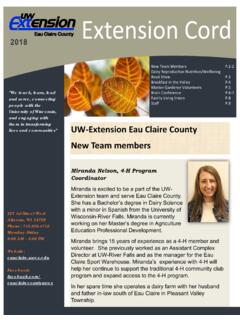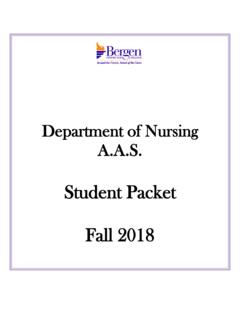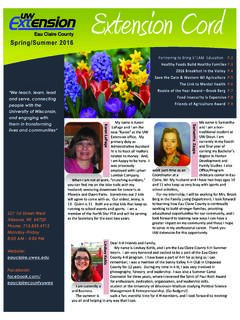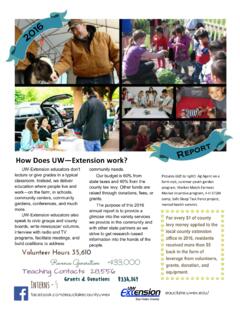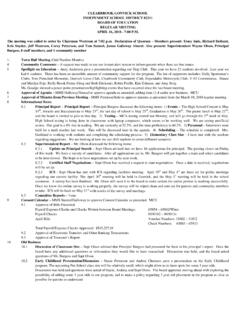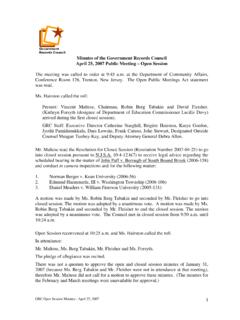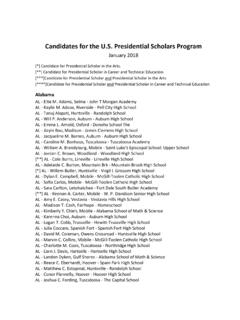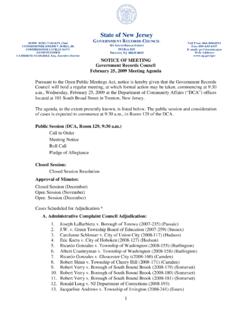Transcription of Interdisciplinary Rounding Toolkit
1 0 Interdisciplinary Rounding Toolkit : A Guide to Optimizing Interdisciplinary Rounds on Inpatient Medical Services Iowa City VA Quality Scholars Fellowship Program May 2014 Interdisciplinary Rounding Toolkit : For more information, please contact VA Quality Scholars (VAQS) Fellowship Program Center for Comprehensive Access and Delivery Research and Evaluation (CADRE) Iowa City VA Healthcare System 601 Highway 6W Iowa City, IA 52246 All documents are available at the following website: Authors Hilary Mosher, MFA, MD VAQS Fellow and Hospitalist Clinical Assistant Professor of Medicine, University of Iowa Carver College of Medicine Daniel Lose, RN, BSN VAQS Fellow and Staff Nurse DNP Student, University of Iowa College of Nursing Russell Leslie, MHA VAQS Quality Improvement Specialist Peter J. Kaboli, MD, MS VAQS Senior Scholar and Hospitalist Director, Veterans Rural Health Resource Center (VRHRC), VA Office of Rural Health Investigator and Associate Director, Center for Comprehensive Access and Delivery Research and Evaluation (CADRE), Professor of Medicine, University of Iowa Carver College of Medicine Interdisciplinary Rounding Toolkit : Contents Executive Summary.
2 1 Introduction .. 2 IDR Tools .. 3 Resident education .. 3 IDR Resident Reference Sheet .. 3 Pocket Card .. 3 Training Video .. 4 The ISDA framework .. 4 Setting .. 6 Facility Support .. 6 Time and Location .. 6 Meeting Flow .. 6 Potential Modifications .. 7 Attachments: .. 8 Appendix A: IDR Team Daily Note Example .. 8 Appendix B: Pocket Card (Front & Back).. 9 Appendix C: Resident Reference Sheet (Front & Back) .. 10 Appendix D: IDR Poster .. 12 Appendix E: Training Video .. 13 Appendix F: References .. 13 1 Executive Summary: Interdisciplinary care is a fundamental component of safe, efficient, and effective inpatient management. To enhance Interdisciplinary care and coordination, many healthcare institutions have begun employing care coordinators, care navigators, and discharge planners, or establishing formal Interdisciplinary Rounding procedures.
3 This Toolkit is directed at establishing and improving the general quality of Interdisciplinary rounds (IDR), particularly in an academic inpatient setting in which medical residents rotate frequently on service and thus may be unfamiliar with the people and processes involved in IDR. This Toolkit outlines an approach to: 1) Optimize Interdisciplinary participation in IDR; 2) Leverage the stable IDR team to provide a learning environment for all team members; 3) Engage residents to be more effective leaders on interprofessional teams; and 4) Meet regulatory requirements for IDR documentation. This Toolkit introduces the ISDA (Identify, Summarize, Discuss, Ask) heuristic and describes how to reinforce this presentation format through the Interdisciplinary Care note template. The Toolkit also contains copies of training references, educational materials, and links to video tutorials that will assist in replicating this system within your unit.
4 Interdisciplinary Rounding Toolkit : 2 Introduction Effective, comprehensive communication is essential for patient safety and high quality, patient-centered care. The effects of inexplicit or missed communication are well known to result in patient harm, frustration and dissatisfaction, extended hospital stays, and preventable readmissions. Furthermore, effective communication also takes time and requires attitudes of mutual respect in order for participants to regard communications as both useful and worthwhile. Interdisciplinary Rounds (IDR) are a prime venue to communicate and coordinate care among healthcare professionals. Early work in choreographing IDR focused on following structured communication tools that guided IDR discussions by providing a checklist or script of items to be covered for all patients on each hospitalization day.
5 However, a drawback of such extensive structure is decreased efficiency, with time spent discussing items of little or no relevance to a particular patient. Furthermore, participants may be aware of highly relevant information but may not bring it up because it is not included as an item on the checklist. Therefore, the challenge and opportunity in IDR is to create an environment of practical and highly effective communication which is also flexible enough to accommodate busy work schedules and a diverse and ever-changing population of patients. The following tools were designed after extensive observation of IDR rounds and can be modified to fit your local organization s needs. Interdisciplinary Rounding Toolkit : 3 IDR Tools Resident education The IDR Reference Sheet, Pocket Card, and Training Video (Appendix) were designed by the VAQS project team to optimize IDR for the Medicine Service at the Iowa City VA Medical Center.
6 The following modules will highlight features of these tools and provide recommendations that may be useful in replicating this intervention. IDR Resident Reference Sheet The goal of this resident reference sheet was twofold. The first was to provide residents with a how-to guide for leading the discussions, and the second was to train them to focus on Interdisciplinary issues most relevant to the patient s phase of care. Often, inexperienced residents provided presentations appropriate to medical rounds, but they needed a guide to direct their thinking regarding broad social, nutritional, rehabilitation, and therapeutic issues. The front page of the reference sheet outlines the ISDA framework for leading IDR discussions, and the back page contains prompts for common Interdisciplinary issues across three main phases of hospitalization (early hospitalization, daily care and preparation for discharge, and planning for an on time departure).
7 Pocket Card The pocket card paralleled the IDR Resident Reference Sheet but was small enough to fit in a resident s white coat pocket. These materials (Appendix B) should be provided to the residents at the beginning of their rotation. This material also outlines the basic ISDA framework and prompts residents preparation prior to their first experience of IDR. Other users may wish to tailor the prompt list to be most relevant to their setting. Interdisciplinary Rounding Toolkit : 4 Training Video As part of the residents orientation to the hospital and prior to participating in IDR, residents are to watch a 6-minute instructional video that provides an overview of the purpose and structure of IDR using the ISDA framework. The ISDA framework The ISDA framework employs a heuristic approach to leading IDR discussions. A heuristic, as opposed to algorithmic, approach to communication provides a basic guide to achieving an end, without prescribing a step-wise set of directions.
8 By focusing on the IDSA heuristic in resident education materials and as the underlying structure for an electronic health record (EHR) documentation template, we instruct residents in how to lead IDR presentations while empowering all interprofessional team members to actively participate in and guide the discussion in their respective areas of expertise. The ISDA heuristic purposefully emphasizes that the resident portion of the presentation is brief, and that discussion and elicitation of input are equally important tasks. By creating a habit of asking for input, we seek to reinforce active participation by all team members. Observations of effective IDR processes revealed that individual patient discussions are highly variable. Some last seconds, and others up to 5-7 minutes. This suggests that effective teams must learn to identify which patients need longer discussions, and that team members should feel empowered to speak up if they feel a discussion is too brief, or an issue has not been raised and resolved.
9 Identify the patient s name, main diagnosis or reason for admission, anticipated discharge date and disposition Summarize the goals of care and treatment plan Discuss and Interdisciplinary issues for daily cares and discharge planning Ask what was missed and what orders need to be placed Interdisciplinary Rounding Toolkit : 5 Interdisciplinary Documentation Template The second component of reinforcing our Rounding format was the creation of document templates that mirror the ISDA framework. In our setting, charge nurses complete the documentation and are enabled to do so during or shortly after rounds. By providing a template that runs in parallel to the intended discussion content and flow, we create an incentive for the charge nurse to encourage the team to adhere to this format. By including this template into the IDR work flow, the charge nurses were able to create a useful document that could be used by staff nurses in the morning to help plan for daily care and discharge needs.
10 This documentation (Appendix A) also met the Provision of Care, Treatment, and Services (PC) measure of success requirement for The Joint Commission accreditation. (Comprehensive Accreditation Manual for Hospitals: The Official Handbook, 2013). Interdisciplinary Rounding Toolkit : 6 IDR Room Setting This intervention bundle was developed within a 42-bed Inpatient Medicine Service at a VA Medical Center affiliated with a university medical center. Medical care on this unit is provided by three rotating resident teams on two medicine units. Each of the medicine units has a stable care team composed of a nurse manager, charge nurses, and a shared team comprised of social workers, nutritionists, palliative care professionals, pharmacists, physical and occupation therapists, and other specialty service professionals.

